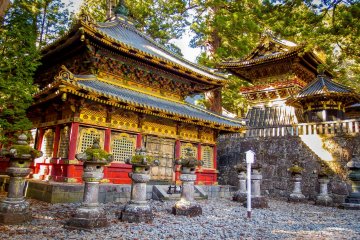
Visiting Nikko’s Toshogu Shrine
Steve MortonDespite being one of Japan’s most popular tourist spots, its fine carvings and immaculate structures are worth seeing again and again!

The Nikko Toshogu Shrine is arguably one of the most important religious sites in Japan and is located in the forests of Tochigi Prefecture. The shrine is the final resting place of Tokugawa Ieyasu, the samurai leader who united Japan in the early 1600s and the first ruler of the Tokugawa shogunate of the same name, which ruled Japan for over 250 years until 1868.
Originally a relatively simple mausoleum, Toshogu was expanded in the first half of the 16th century by Ieyasu's grandson Iemitsu to create the spectacular complex that can be visited today. The shrine complex consists of more than a dozen buildings, which have been refined with countless wood carvings and large amounts of gold leaf. This is very unusual as there is usually an emphasis on simplicity in shrine architecture. Toshogu contains both Shinto and Buddhist elements. The wood carving of the monkeys who see no evil, speak no evil, and hear no evil is best known.
With over 500 intricate carvings, the Yonmeimon is known as one of the most beautiful gates in Japan. Rows of elaborate golden dragons are carved onto the huge gate that marks the entrance towards the main shrine building. Yonmeimon gate is rightfully designated as a National Treasure, and is also known as the “Main Gate of the Imperial Court”.
Nemurineko, or Sleeping Cat, is a detailed wooden carving by Hidari Jingoro. The carving depicts a cat falling asleep while surrounded by flowers. Nemurineko is located at the East Corridor of Toshogu Shrine, where it's easily spotted by the crowds of visitors clamoring to take a photo of it.
One of Toshogu Shrine’s most famous sights, the lifelike wooden carving of three monkeys are located at the stable building within the complex. The monkeys represent those who hear, speak, and see no evil — a common saying in East Asian culture.

Despite being one of Japan’s most popular tourist spots, its fine carvings and immaculate structures are worth seeing again and again!
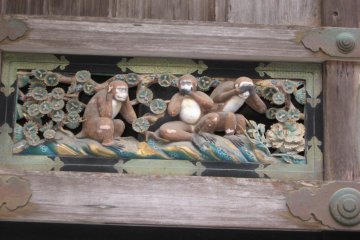
A part of ‘Shrines and Temples of Nikko’, a UNESCO World Heritage site, this shrine is believed to be one of Japan’s most lavishly decorated shrines.

Impressive shrine complex; through the fantastic setting, bright colors and elaborate decorations one can still feel the wealth and power during the Tokugawa shogunate.
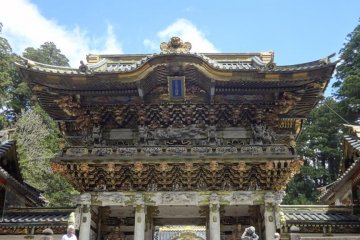
Tosho-gu is directly north of Edo Castle—the residence of the king of this world. Ieyasu thought that Tosho-gu would be the residence of the king of the afterworld.

Kano Tanyu designed huge numbers of sculptures and carvings for each building. There are 5173 in total. I would like to focus on some interesting points for you to see
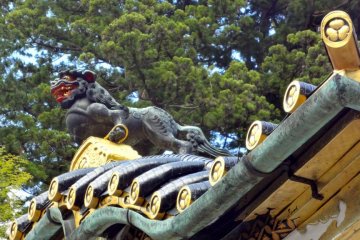
Enshu secretly introduced various Western styles into Tosho-gu. The three main techniques he used in there were: Perspective, Vista, and the “Golden ratio”.

Even after visiting Tosho-gu Shrine in Nikko more than 15 times, I still enjoy its different faces, depending mainly on the season and time of day I go. 400 years ago, in

Nikko Toshogu Shrine's annual grand festival features the Yabusame tradition—horseback archery—and the Togyosai where portable shrines are moved in a procession.

Designated as a World Heritage site since 1999, thousands of locals gather at Toshogu Shrine to parade in Nikko’s traditional warrior attire.

Hongu Shrine in Nikko is an auxiliary shrine of Futarasan Shrine. Registered as one of the 103 World Heritage buildings of the Temples and Shrines of Nikko, Hongu Shrine features stone torii gates, a vermilion worship hall, good luck stones and the popular Hongu Cafe.

As part of the 'Shrines and Temples of Nikko,' Nikko Toshogu Shrine, located in Tochigi Prefecture, was registered as a World Cultural Heritage site in 1999. The decorative detail of its architecture is amazing and well worth the visit to see.

Focusing on the mix of decorative patterns and natural textures at Nikko's most famous shrine, Tōshō-gū.

I'd like to share the beauty of Nikko with you--in the rain. This story focuses on the nooks and crannies of the area just OUTSIDE Toshogu Shrine. Very beautiful.
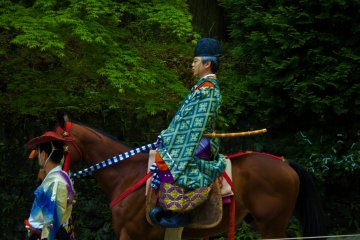
Yabusame Archery Competition at the Nikko Shunki Reitaisai Grand Spring Festival.

Traditional Japanese ryokan and its facilities and the walk along the main street of Nikko Town.

Nikko Kanaya Hotel commands the best location for access to Nikko’s World Heritage Site. You can enjoy every bit of Nikko’s charm with this hotel as your Nikko base.
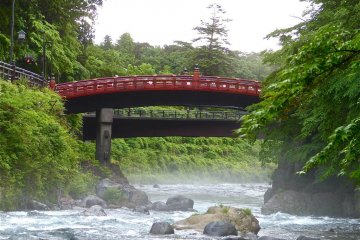
If you stay at the Kanaya Hotel, I recommend that you become an “early bird”. You will never forget the mystic view of the Shinkyo red bridge, and the emerald green river
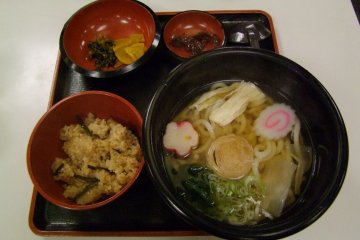
Honke Yamabiko is a wonderful noodle shop conveniently located next to the World Heritage shrines and temples in Nikko. Stop in for some delicious local yuba dishes.

Try Nikko's specialty dish of yuba at Honke Yamabiko Restaurant, steps from the entrance to Toshogu Shrine

There is an excellent restaurant specializing in eel in Nikko called Sawamoto. In fact, their broiled eel is the best I have ever had.
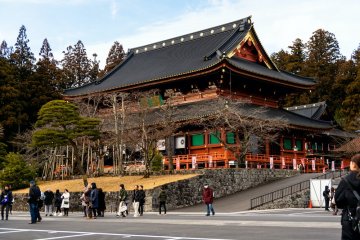
Among Nikko’s many world-renowned temples, stands the vibrantly colored Rinnoji (輪王寺), which was designated as a UNESCO World Heritage Site in 1999. Shodo Shonin, a Buddhist monk credited for introducing Buddhism to Nikko, founded the temple in the eight century. Lush forests and the mountainous landscapes of Mount Nantai, Nyoho, and Taro surround the collection of buildings, creating an atmosphere of sacred solitude. Many notable Buddhist figures were drawn to the temple’s pious isolation, including Kukai, the founder of the Shingon School of Buddhism, and Enjin, a priest of the Tendai School of Buddhism.

Tamozawa Imperial Villa is a former imperial summer residence in Nikkō, Tochigi Prefecture, Japan. It was constructed for Emperor Taishō in 1899 and served as a hide-out for emperor Hirohito during World War II. The former imperial residence is now open for the public as museum and garden. [Wikipedia]
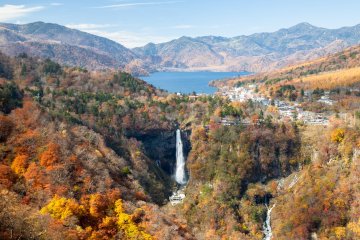
The Kegon Falls are located on Lake Chuzenji in Nikko National Park in Tochigi Prefecture. The 97-meter-high falls are one of Japan's top three waterfalls and are also considered one of the top eight viewpoints in Japan from the Showa period. Overall, they exist 12 waterfalls, all located under or parallel to a large waterfall, the other two famous waterfalls are Nachi Waterfall in Wakayama Prefecture and Fukuroda Waterfall in Ibaraki Prefecture. They are especially popular during the fall foliage season when visitors travel to Nikko to admire the golden-orange colors. You can use an elevator there to see everything up close. In winter, the waterfalls even freeze over completely.